 |
Indiana Jones
The Great Circle
Video game
Developed by Bethesda
Softworks with Lucasfilm Games
Released December 5, 2024
|
Indy races the Nazis to uncover the
mysteries of humankind's greatest sites of spiritual
significance around the globe and learn the secret of the sites'
Great Circle.
Read the
story summary of The Great Circle at the
Wikipedia
Notes from the Indiana Jones chronology
This story takes place in October through early November 1937,
according to the dates noted in the journal Indy keeps in the
game.
Didja Know?
Indiana Jones and the Great Circle is a 2024 video
game originally playable on the
Xbox Series X
and S,
PlayStation
5 video game
system, Microsoft Windows PC operating
system, and available through digital distribution on
Steam.
Throughout the game, Indy carries his
Smith &
Wesson M1917 revolver.
Notes from
The Lost Journal of Indiana Jones
The Lost Journal of Indiana Jones is a 2008 publication
that
purports to be Indy's journal as seen throughout The
Young Indiana Chronicles
TV series
and the big screen Indiana
Jones movies. The publication is also annotated with notes
from a functionary of the
Federal Security
Service (FSB) of the Russian Federation, the successor
agency of the Soviet Union's KGB security agency. The KGB relieved Indy of his
journal in 1957 during the events of Indiana
Jones and the Kingdom of the Crystal Skull.
The notations imply the journal was released to other
governments by the FSB in the early 21st Century. However, some
bookend segments of The
Young Indiana Chronicles
depict Old Indy still in
possession of the journal in 1992. The discrepancy has never
been resolved.
The journal as published does not mention the events of this
game, going from the end of
Raiders of the Lost Ark
in 1936 to
Indy's recovery of the Cross of Coronado in 1938 in The Last
Crusade. (Of course, the journal was published long before
this game was developed).
Characters appearing or mentioned in this video game
Indiana Jones
Barranca (in dream sequence only, deceased)
Satipo
(in dream sequence only, deceased)
Quechan porters (in dream sequence only)
Hovitos warriors (mentioned in dream sequence only)
Marya Smirnova
(mentioned only)
Forrestal
(mentioned only, deceased)
Marcus Brody
Marion Ravenwood (voice in Indy's dream only)
Locus
S. Bedini (mentioned only)
T. Keeler (mentioned only)
L. Komarov (mentioned only)
Willie Scott
(mentioned on school dance flyer only)
August
Björkmann
(mentioned only)
Theresa Lawrence
(mentioned only)
Shirley
(mentioned only)
Dawson (mentioned only)
Kittridge
(mentioned only)
Father Antonio Morello
Blackshirts
Benito Mussolini
Pope Pius XI
(mentioned only)
Father Cesare Ventura
Father Raphael Caruso
(mentioned only)
Valeria Mollino (mentioned only)
Officer Luca Accardo (mentioned only)
Captain De Vito (mentioned only)
Dante
Rossi
(mentioned only)
Fascists
Father Russo
(mentioned only)
Father Amato
(mentioned only)
Signor Smushki (cat)
Alessandro Pesaro
(mentioned only)
bruisers
Giovanni (mentioned only)
Uncle Mario
(mentioned only)
Father Crescenzo (remains only)
nuns
Fascist soldiers
Ernesto
Giuseppe Marefoschi
(mentioned only)
Sister Catherine Bennett
Sidney
Bishop Marsico
(mentioned only)
Aureliano Mantovani
(mentioned only)
Andrea Ciarlante (mentioned only)
bulldozer driver
Ginetta (Gina) Lombardi
Emmerich Voss
Dr. Laura Lombardi (voice only, found deceased)
Father Luis
(mentioned only)
Father Nicoletti
(mentioned only)
Guiliana
Nazi soldiers
Andres Silvio Uribe
(mentioned only, deceased)
Rene Belloq
(mentioned only, deceased)
Colonel (Oberst) Viktor Gantz (dies in this game)
Bertram Bergmann
Egyptian laborers
Dr. Kafour
Dame Nawal Shafiq-Barclay
Osiris (Nawal's pet snake)
Professor
Omar
Nawal's contact
snake charmer
Asmaa
Tausret (Asmaa's monkey)
Hauptfeldwebel Pohl
(mentioned only)
Colonel Joseph
(mentioned only, deceased)
General Klebér
(mentioned only, deceased)
Napoleon Bonaparte
(mentioned only, deceased)
Meier
(mentioned only)
oud master
Sallah
(mentioned only)
Sallah's uncle (mentioned only)
carpet merchant
senet players
delivery boy
Captain Klaus Schmidt
(mentioned only)
Lukas Schwartz
(mentioned only)
Hauptsturmführer
Theodor Engel (mentioned only)
Wagner (mentioned only)
Schnecke (mentioned only)
Heinrich Pflüger
(mentioned only)
Professor Aldrich Savage
Himalayan guide
Captain Konrad Altrichter
(found deceased)
Fried Egg (cat)
Enzo
(mentioned only)
hotel guests
hotel manager
former hotel room tenant
(mentioned only)
Uncle Sunan
Khaimuk Saksit villagers
Siamese rebels
Tieng
Mano
Pailin Chaladphukhealom
Siamese general
(mentioned only)
Tongdang
Nŏo
village storyteller
Francesco
(mentioned only)
Lorenzo
(mentioned only)
Bartolomeo
(mentioned only)
Annika Lund
Möller
(mentioned only)
Didja Notice?
Prologue: South America
The game opens with a recreation of the
prologue of
Raiders of the Lost Ark,
with Indy, Barranca, and Satipo searching the Peruvian
jungle for the ancient temple that holds the Chachapoyan
idol in 1936. Here in the game, the temple is referred to as
the Blood Temple, while in the novelizations it is referred
to as the Temple of the Chachapoyan Warriors. The Blood
Temple name is borrowed from the 2023 board game Indiana
Jones: Cryptic made by Funko.
This version of the prologue is revealed to be a
dream reliving the 1936 events (moderately altered) that Indy has
in October 1937.
Indy finds the abandoned campsite of Dr. Forrestal in the
jungle.
Dr. Forrestal was an archeologist mentioned, but not seen,
previously in
The Viking Scroll and
"Tomb of the Gods" Part 2,
and, in
Raiders of the Lost Ark,
Indy remarks that Forrestal cashed in his chips at the
Chachapoyan temple. Indeed, Indy found Forrestal's skewered
body in the temple in that film.
In the campsite, Indy finds a book belonging to Forrestal,
Warriors of the Clouds: My Journey Through the Ruins of
the Chachapoyan Culture by Marya Smirnova; Indy mutters
that the book was Forrestal's favorite. Marya is a
journalist friend of Indy's, as seen previously seen in
Secret of the Pyramid,
The City of
Lightning, and
The Cursed Grimoire.
Barranca pulls a
Smith &
Wesson Mk II revolver on Indy here (the same model Indy
uses), but in the original film, it was a
Remington 1875.
In this dream sequence, within the temple Indy must continue
pressing on certain floor tiles (ones with a circular
indentation in the middle) with his torch to activate the
proper footpath to the altar of the idol. This is a bit
different than what happened in the original scene in
Raiders of the Lost Ark.
In this dream sequence, Indy reaches under the closing stone
doorway just in time to grab his hat out. In the original
sequence in
Raiders of the Lost Ark,
it was his whip he pulled out.
In this dream sequence, Indy is seemingly flattened by the
rolling boulder he originally outran in the earlier film, waking him
up at his desk in his office at Marshall College. During his
attempted flight from the boulder, Indy hears the voices of
Marcus and Marion berating him; these lines of dialog are
from
Raiders of the Lost Ark.
When Indy awakens, he finds that Marcus has also fallen
asleep on the office couch. Marcus is clutching the book
The Lone Explorer by R.J. Adams. Adams is soon revealed
to have been associated with the college in the past, and
was awarded a plaque from the Geology Institute for
"excellence in sedimentary geology" from 1899—1929. "Geology
Institute" could refer to any of a number of real world such
institutes.
In his sleep, Marcus seems to be mumbling about the time he
got lost in his own museum, an event also referenced in
The Last Crusade.
| To the right
is Indy's office
at Marshall College. |
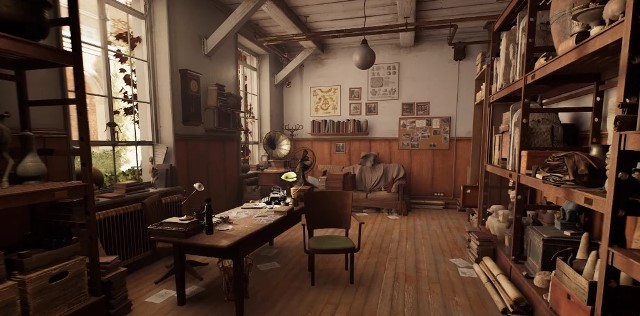 |
The Break-In
Indy finds his own faculty identification card in the
ransacked room in Woolley Hall of the college. The back of
the card has the words SAPIENTIA ET LUX printed on
it. This is Latin for "WISDOM AND LIGHT". The first mention
of Woolley Hall was in the 1994 Raiders of the Lost Ark
Sourcebook for the The World of Indiana Jones
roleplaying game.
Indy picks up a Campus Overview map of Marshall College.
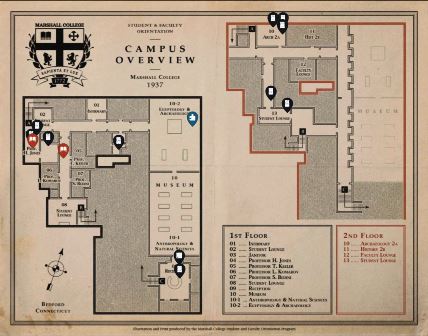
A letter written by August Björkmann found in the school
mentions archaeologist Theresa Lawrence's theft of the
Uppsala Scroll years earlier. This refers to events in
"The Viking Scroll".
The Marshall College newsletter mentions that renovations to
the lecture halls has begun. This may be meant to explain
some differences seen on campus here compared to earlier in
Raiders of the Lost Ark
and later in Kingdom of the Crystal Skull.
Indy and Marcus find most of the artifacts from the
ransacked display case scattered on the floor. A couple of
the relics are: a
Bastet statue (a fertility goddess of ancient Egypt with the
head of a cat) and a gold funerary mask with Ugaritic
engravings from
Ras Shamrat, Syria.
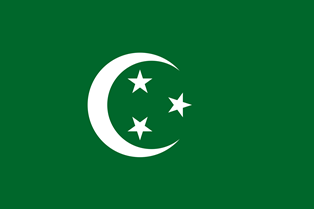 |
The flag emblem seen on the marker card next to
the display stand for the Bastet statue is that of
the Kingdom of Egypt from 1922-1953. |
| |
|
 |
The flag emblem seen on the marker card next to
the display stand for the Ugaritic mask is that of
the nation of Syria. |
Indy realizes that one artifact is missing from Wooley Hall, a cat mummy from
Siwa that he had recovered from the site six weeks earlier
in the year (so, around the beginning of September).
Siwa
is an urban oasis in Egypt. It is famous for
being the site where Alexander the Great consulted the
oracle there, who proclaimed that Alexander was the son of
Amun (one of the major Egyptian gods) and therefore the
legitimate Pharaoh of Egypt.
Searching for clues to the identity or origin of the thief (Locus),
Indy finds an article torn out of a newspaper. The
newspaper's name is partially missing from the top where it
was torn, with only "--ord Post" visible. This is
likely meant to be "Bedford Post", Bedford being
the name of the fictitious town in which Marshall College
exists. The article itself refers to Mussolini and his MVSN
(commonly known as Blackshirts) ruling Rome with an iron
fist.
This is a reference to the Italian dictator Benito Mussolini
(often called Il Duce) and his Fascist party, who ruled Italy from 1922-1943. The
MVSN (Milizia Volontaria per la Sicurezza Nazionale;
Voluntary Militia for National Security) is the paramilitary
wing of the National Fascist Party, distinguished by their
black uniforms.
Rome
is the capital and largest city of Italy.
On Indy's desk is a map of the
Temple of the Forbidden Eye. This is the temple seen in the
Disneyland ride Indiana Jones Adventure: Temple of the
Forbidden Eye. It is generally said within the
Indiana Jones canon that he discovered the temple by
piecing together map fragments and following the route, on
the banks of the Bengal River in India in 1935, shortly after
his adventure at Pankot Palace in
The Temple of Doom.
| Locus' medallion, left behind
during his escape from the college, is said by Marcus to be
the sigil of the Vatican Secret Archive. This is the former
name of the
Vatican Apostolic Archive. As far as I can tell, this
sigil is fictitious. |
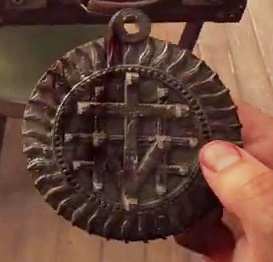 |
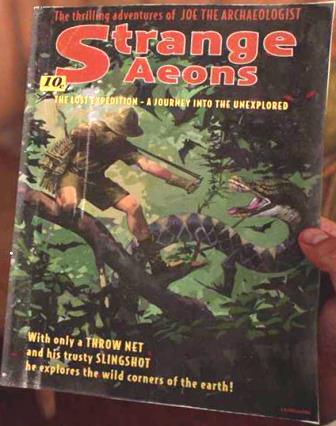 |
A pulp magazine called Strange Aeons #1 can be
found in a small lounge of the college. It does not seem to
be important to the game, but does grant the player some
Adventure Points when found. A number of random articles
like this can be found throughout the game. The magazine is
fictitious, but it's amusing to note that the cover story is
about the "thrilling adventures of Joe the Archeologist."
"With only a throw net and his trusty slingshot he explores
the wild corners of the earth!" |
| Another "Adventure Points" item to
be found in the college is a baseball card. It does not
appear to be a real world card, but is very reminiscent of
baseball cards and player poses produced at the time. Indy
was seen to be a big baseball fan and a collector of cards
featuring his favorite players in The Young Indiana
Jones Chronicles. |
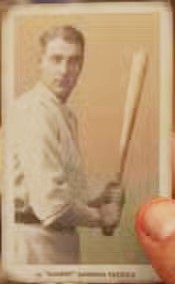 |
A letter found in a student desk in Indy's classroom
(another Adventure Points item) is from "Shirley", now
revealed as the girl who had "LOVE YOU" written on her
eyelids for him in
Raiders of the Lost Ark.
While packing for his trip to
Italy, Indy tosses in a gramophone record to use as a
potential gift for someone. It is from Gramodec Records. This appears to be
a fictitious company. The unnamed song is said to be by
Prince Jimmy and his Orchestra, but the Indiana Jones
and the Great Circle soundtrack album lists the song as
"Count G" by modern day composer
Gordy Haab.
Indy later does make a gift of the record to
Father Morello at the Vatican, an old friend of his from the
war.
Indy flies from
New York City
to Rome.
The
Castel Sant'Angelo is an actual historic building in
Rome, also known as the Mausoleum of Hadrian.
The Stolen Cat Mummy - Castel Sant'Angelo
During his time exploring Vatican City, Indy encounters a
number of cats. Rome, and, therefore, Vatican City, is known
for its large population of feral cats.
In the grounds of the Castel Sant'Angelo, Indy overhears a
pair of Blackshirts talking about Mussolini's interest in
accessing the Vatican and that the pope is currently ill.
The pope at this time was Pius XI. Indy mumbles about the
pope being Mussolini's propaganda mouthpiece. Pope Pius was
controversial in his time, largely for his cooperation with
the Fascist rulers of Italy, though his acceptance of them
was nuanced and he was critical at times. He was in a
difficult position as leader of the Vatican (and the
Catholic Church) with it being literally fenced in by
Fascist Italy.
The Italian Blackshirts are armed with Beretta M1934
pistols.
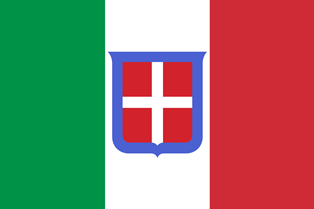 |
As Indy searches through the Castel Sant'Angelo and
takes out Blackshirts, the flag of the Kingdom of Italy is
seen a few times. This flag was in use in Italy from
1861-1946. |
In Castel Sant'Angelo, Indy finds a
copy of Storie del Terrore #1 (Tales of Dread
#1). This is another fictitious pulp magazine.
Indy also finds books called Temperamento da
Gentiluomini: Gestire la Rabbia Con Disciplina (Gentlemanly
Temperament: Managing Anger With Discipline) by Cetteo
Pavone and Dailo Smacco Allo Scacco Vol 1: La Rimonita
Neggli Scacchi (Give It A Whistle To Check Vol 1:
The Reprimand In Chess) by Benedetto Cernigoi. These
are fictitious books and authors.
Another item found by Indy is a postcard of the
Gizeh Pyramids addressed to Allessandro from M.
A poster for a boxing club is seen pinned to a bulletin
board in the castel, Circolo di Pugilato Segreto
(Secret Boxing Circle).
Next find is a the book Baruffe di un Giovane Teppista
(Brawls of a Young Hooligan) by Leopoldo
Sacripanti. Fictitious book and author.
The hearing aid device worn by Father Antonio Morello seems
smaller and a bit more sophisticated than the
electronic
aids actually available in the 1930s.
The character of
Father Cesare Ventura is probably based on the historical figure
Father Pietro Tacchi Venturi (1861-1956). Both the
fictitious Ventura and historical Venturi are friendly with
Mussolini and act as unofficial liaisons of the Vatican to the Italian
ruler and both are known as the "Man in Black".
Father Morello refers to Indy as "Henri" and remarks that it
has been 19 years, with Indy agreeing, saying, "...since the
infirmary by the Piave." The Piave is a river in Italy and
it was the main line of defense of Italy during WWI. It
seems that Indy and Morello served together in the war in
1918, where Indy was known by his nomme de guerre of Henri
Defense of Belgium. Morello was not introduced in any
episodes of The Young Indiana Jones Chronicles
(which depicted a number of Indy's WWI adventures), but
there are a number of gaps in the Chronicles chronology to
be filled in.
When a touched Father Morello receives the Gramodec record
from Indy as a gift, he says, "Gracie, amico mio..."
This is Italian for "Thank you, my friend..."
When Indy awakens from his nap in the
Vatican, with Father Morello listening joyfully to the jazz
record, the father greets him, "Buongiorno! This
American music is astounding! How do they play like that?"
Buongiorno is Italian for "Good morning".
Indy has written the day's date in his journal,
October 23, 1937.
Father Morello remarks that the Vatican chef, Giovanni,
makes a good risotto ai funghi. This is a rice dish
cooked with broth and mushrooms.
Father Morello gives Indy a clerical suit to wear while in
the Vatican and when the archeologist adventurer puts it on,
Morello says, "Perfetto, Indy. You should have
become a man of the cloth." Perfetto is Italian for
"perfect".
In the Vatican clerical outfit, Indy uses the alias of
Father Gallagher from St. Joseph's in Boston. It's possible
Indy is referring to the real world
St.
Joseph Catholic Church in
Boston.
Indy begins a search of the
Vatican Apostolic Library for the sigil on the medallion
left behind by the giant thief (Locus).
During his library wanderings, Indy finds a flyer regarding
briscola. This is a popular Italian game played
with a standard Italian 40-card deck.
When Indy finds the secret entrance opened by the sigil
medallion, Father Morello discovers him and says, "Madre
di Dio...What have you found, Indy?" Madre di Dio
is Italian for "mother of God".
Indy finds an old letter from Cesare Borgia. Borgia
(1475-1507) was an Italian Roman Catholic deacon and later
cardinal, who went on to become a mercenary! He was also an
illegitimate son of Pope Alexander VI of the House of
Borgia. His quest for power was part of the inspiration for
Machiavelli's illustrious treatise The Prince.
The mystery note Indy finds in the Borgia tower is a poem.
It appears to be an original poem for the game.
In Vatican City, Indy enters Belvedere Courtyard. This is an
actual architectural work within the Vatican.
Indy finds a recipe for Cacio e pepe. "Cacio e
pepe" is Italian for "cheese and pepper" and is a spicy pasta dish.
Indy finds a ticket stub for the Virgilio Cinema & Theatre
on the Strada dei Mattoni Gialli in Rome. This appears to be
a fictitious theatre. The road it's on is also
fictitious, and translates to "Yellow Brick Road" (the road,
or path, that winds through the Land of Oz in the Oz
book series by L. Frank Baum, and, most famously, in the
1939 movie adaptation, The Wizard of Oz)!
Another "Adventure Points" book Indy finds is Tennista
D'elite: Mantenere L'attrezzatura Nell'etadel Jazz (Elite
Tennis Player: Maintaining Equipment in the Jazz Age)
by Alessandro Pesaro. Both book and author appear to be
fictitious.
In the course of the video game,
Indy may find a Venus figurine held by one of the skeletons
in a secret room off the interrogation room. A Venus
figurine is a type of small sculpture from the Upper
Paleolithic, 50,000-12,000 years ago, depicting a woman,
often pregnant or with exaggerated features.
Ernesto calls Indy signore. This is Italian for
"sir".
In the Vatican Post Office, Indy buys a camera from Ernesto
and also looks at a pamphlet there called Leggende e
Misteri Locali del Vaticano Antologia (Local
Legends and Mysteries of the Vatican
Anthology).
Another "Adventure Points" book: Oltre il Crinale
(Beyond the Ridge) by Aureliano Mantovani.
Another "Adventure Points" book: Il Regime Armonico di
Forza e Spirito (The Harmonic Regime of Strength
and Spirit) by Andrea Ciarlante.
At one point, Indy mumbles, "Be you therefore perfect, even
as your Father who is in heaven is perfect." This is a
passage from the Bible's Matthew 5:48.
After taking numerous photographs of the inscriptions around
Vatican City with the camera he bought from Ernesto, Indy
somehow immediately has the photos to show to Father Morello
without having to get the film developed! He also hands out
instant photos to some other people along the way in his
wanderings through the Vatican. (No, the camera
was not digital (heh-heh)...and not a Polaroid or instant camera,
which was not available until 1948!)
When Indy reads a clue from Latin inscriptions of "the
crusade that did not happen", Father Morello remarks, "The
crusade that did not happen...Dum Diversas?" Dum
Diversas ("While Different") is a papal bull issued by
Pope Nicholas V in 1452. It authorized King Afonso V of
Portugal to conquer Saracens and pagans and consign them to
"perpetual servitude".
The Tower of Nicholas V inside Vatican City may be a veiled
reference to the real world Niccoline Chapel, but they don't
look much alike.
In the tower, Indy finds an ancient parade helmet made in
the 4th Century BC by the La Tène culture of the Gaul
region. Gaul was a large region of Western Europe from 5 BC
to 5 AD, encompassing present-day France, Belgium,
Luxembourg, and parts of Switzerland, Netherlands, Germany,
and Northern Italy. The La Tène culture existed there
from about 450-1 BC.
While continuing to solve the "Sacred
Wounds Puzzle" in the tower Indy speaks the words, "For this
is my blood of the covenant, poured out for many unto
remission of sins." This is from Matthew 26:28 of the
Bible, spoken by Jesus.
Indy continues to mumble assorted Bible
passages, such as "...they saw Jesus approaching the boat,
walking on the sea--and they were terrified..." and "...and
he took a cup, and gave thanks, and gave to them, saying
'Drink ye of it..." and "...and he gave to the disciples, and
said, 'Take, eat; this is my body...'" and "...and she
anointed the feet of Jesus, and wiped his feet with her
hair..."
As part of the puzzle, Indy also identifies a statue of
Longinus, the Roman soldier who pierced the side of Jesus
with the Holy Lance during the crucifixion. The Holy Lance,
also known as the Spear of Destiny, will become the object
of Indy's search in 1945 in The Spear of Destiny.
Indy reads from an old document that the Fountain of
Confession in Vatican City is the entrance to the sacred monastery of the
Nephilim order. The Fountain of Confession appears to be
fictitious, as is the Nephilim order, but Nephilim are
mentioned in the Bible as beings of great size and
strength, i.e. giants. Some interpretations suggest that the
Nephilim were wiped out in the Great Flood.
A statue of Oceanus, the Titan son of Uranus and Gaia in
Greek mythology, the father of the river gods and the
Oceanids, and the personification of the great river which
encircled the entire world, is found in one of the rooms of
the catacombs. In another is a statue of Nike, goddess of
tennis shoes.
While following the sneaky nun (Gina)
into a Vatican building, Indy finds a torn newspaper page
about a surprise Japanese air bombing run in Shanghai. This
refers to the Battle of Shanghai of August-November of 1937
during the Second Sino-Japanese War.
The newspaper's name is half torn off, leaving only
"Corriere di". Corriere is Italian for
"Courier".
Indy tells Gina that Emmerich Voss is a German archeologist
and leader of the Führer's occult research program.
Voss is a fictitious character, though the Führer
(German leader Adolf Hitler) is said by some researchers to
have been obsessed with the occult (though others say it was
mostly Heinrich Himmler's obsession and Hitler merely
allowed him to pursue the subject through Nazi resources).
Here, Voss works with the Third Reich Special Antiquities
Collection. This is the same fictitious organization that Toht worked
for in
Raiders of the Lost Ark.
Indy sarcastically remarks to Gina, "The Lord revealeth his
secret unto his servants." This phrase is a Biblical
concept, suggesting that God communicates his plans and
knowledge to those who are devoted to him and carry out his
will.
Gina refers to Indy as strambo. This is Italian
slang for "weirdo". She continues to use this nickname for
him intermittently throughout the game. Cute.
After his first meeting with Gina, Indy finds another
"Adventure Points" book, Sotto il Sole Italiano:
Scampagnate e Cosa Portare (Under the Italian Sun:
Picnics and What to Bring).
Indy finds a letter from Father Nicoletti to Father Luis
about a copy of the Secretum Secretorum made for
the Portuguese queen in the 12th Century. The Secretum
Secretorum (Secret of Secrets) is a medieval
treatise, purportedly a letter from Aristotle to Alexander
the Great, covering a range of topics including statecraft,
ethics, physiognomy, astrology, alchemy, magic, and
medicine. The first Latin translation was made by John of
Seville for Queen Tarasia of Portugal around 1120.
Indy spies some wooden statuettes of St. Peter and St. Paul.
St. Peter was one of the Twelve Apostles of Jesus. St. Paul
was on the road to Damascus when the resurrected Jesus
appeared before him.
When Indy gives Father Morello the leather parchment he
found that talks about a secret order within the Vatican,
Morello says, "This is astounding. Grazie, Indy."
Grazie is Italian for "Thank you."
While Indy is exploring around the area of the Fountain of
Confession, a conversation between a chimney sweeper and a
labor manager can be heard, with the manager telling the
sweeper, "You've got to get the chimneys cleaner that that,
boy. If the public sees black smoke, they'll think we're
choosing a new pope." Black smoke emerging from the Sistine
Chapel chimney indicates the cardinals are meeting to elect
a new pope. White smoke indicates that a new pope has been
elected. The Sistine Chapel is a famed chapel is the
Apostalic Palace of the Vatican.
On one of the sidequests, Indy may find a golden xiphos. A
xiphos is a double-edged, one-handed shortsword that was
used by the ancient Greeks.
In the course of the game,
Indy may find an Aduno Koro sculpted by the Dogon people in
the 17th Century. An Aduno Koro is an "ark of the world",
sent by the Creator to reorganize and populate the world.
The Dogon are an indigenous ethnic group of the central
plateau region of Mali, West Africa; they are known for
allegedly having astronomical knowledge that could not be
discerned by their naked-eye observation, inviting
speculation of extraterrestrial visitation in the distant
past, supported, in part, by the civilization's own
mythology.
As Indy tells Gina, the ark of bulrushes is the small vessel
that is said in the Bible to have carried the baby
Moses down the river to protect him from the Egyptian
mandate to drown every male child.
As Indy and Gina head down into the bowels of the Fountain
of Confession, Gina remarks, "Oh, mio Dio. It's a
long way down, isn't it?" Mio Dio is
Italian for
"My God".
At one point, Indy remarks to Gina that journalism probably
doesn't usually mean exploring old catacombs and she
responds it's usually things like spying on Fascist meetings
and reporting from the Ethiopian warfront. "Ethiopian
warfront" probably refers to the Second Italo-Ethiopian War of
October 1935 to February 1937.
As Indy pulls the lever to start the Gold Forge, Gina asks,
"Una fucina?" This is Italian for "A forge?"
In the catacombs, Indy and Gina light up two forges, of gold
and silver, to cast two sacred keys used to open two
chambers in the catacombs. After the casting the keys in the
molten metals, Indy is able to grab and use the key
immediately, seemingly without allowing the lengthy amount
of time necessary for the metal cool and harden first! (This
kind of thing...including the the instant "photographs" Indy
takes with his camera...is what annoys me about video game
storytelling.)
Indy reads from a stone tablet about "passing through fire"
and he remarks that it is a reference to Isaiah. In the Book
of Isaiah of the Bible, it is said, "Through the
wrath of the Lord of hosts is the land darkened, and the
people shall be as the fuel of the fire."
Indy takes a photograph of a Metatron statue. Metatron is an
angel in Judaism, Gnosticism, and Islam, mentioned in the
Talmud.
After threatening to expose Father Ventura's sins and of taking
the Great Circle relics from the Treasury of Esoteric
Artifacts, Voss tells the father, "Arrivederci." This is
an Italian word meaning "Until we meet again."
In the Treasury of Esoteric Artifacts, Indy discovers a
"Ziggurat Dig Report" of the Vatican Secret Agency from
1922. It describes an expedition to Ur, Iraq lead by Andres
Silvio Uribe, accompanied by two young archeologists, Henry
Jones, Jr. and Rene Belloq. Uribe is a fictitious
archeologist; his son and daughter become involved with a
plot against Indy later in 1937 in "The Arms of Gold". A
ziggurat is a somewhat pyramidal structure built in ancient
Mesopotamia. The Vatican Secret Agency is fictitious, though
many researchers do believe the Vatican has been involved in
intelligence gathering and covert activities throughout its
history. Ur was an ancient Mesopotamian city-state in what
is now modern-day Iraq.
| Indy finds a list of where the
Great Circle artifacts in the Treasury of Esoteric Artifacts
were originally found. All seven sites are real world
locations. |
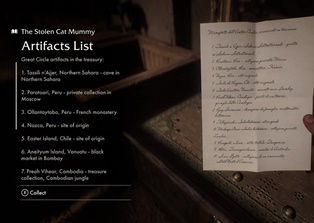 |
Indy warns Gina that he's had a run-in with the Nazis before
"and it ain't no walk in the park." Perhaps he is being
modest when he says he's had a run-in; he's dealt
with Nazis a number of times in the past, though most
notably in
Raiders of the Lost Ark.
When Indy and Gina exit the catacombs and emerge back into
Vatican City, they see a Nazi zeppelin docking to the dome
of
St. Peter's Basilica.
The Nazi soldiers are seen armed with Luger P-08 pistols.
Indy overhears two Nazi soldiers talking, one asking,
"Wasn't Leonardo da Vinci Italian?"
Da Vinci (1452-1519) was Italian and one of the most noted
polymaths of the Renaissance period.
Inside the basilica, Indy picks
up a bottle of Avellino amaro. Amaro is an Italian herbal
liqueur typically consumed as a digestif. "Avellino" would
seem to be the brand name, possibly being from the Avellino
region of Campania, Italy.
Indy names off a number of ancient historical sites that he
says are part of the Great Circle legend. They are all
actual historical sites, but they do not line up in a
perfect circle around the globe as he states here. Also,
the Great Circle legend itself is one made up for the game.
The Race is On
Indy finds a top secret German document from Adolf Hitler
which assigns the zeppelin Z-30 to Operation Great Circle.
The document reveals that Voss has the paramilitary rank of
sturmbannführer (major) in the SS (Schutzstaffel).
The escape hatch Indy opens in the bottom of the Z-30 when
it arrives in Gizeh has ACHTUNG STURZGEFAHR stenciled on top.
This is German for ATTENTION: RISK OF FALLING.
A German flying wing, similar to the one seen at Tanis in
Raiders of the Lost Ark,
is seen in Gizeh as the Z-30 lands.
The Wehrmacht mentioned snidely by Voss to Gantz
after arriving in Gizeh is the name for the unified German
armed forces from 1935-1945 during the Nazi reign.
The Idol of Ra, said to have once been in the possession of
Khufu, appears to be a fictitious relic. Khufu was the
second pharaoh of the Fourth Dynasty of Ancient Egypt, in
the 26th Century BCE.
Nawal has a sketch she made of Margaret Murray. Indy remarks
that Murray is currently doing an excavation in
Petra.
Murray (1863-1963) was an Anglo-Indian anthropologist,
archaeologist, Egyptologist, folklorist, and historian, and
the first woman to be appointed as a lecturer in archaeology
in the United Kingdom.
A book called Pure Paraffin is seen in Nawal's
tent. This appears to be a fictitious book. Paraffin is a
type of wax.
Nawal tells Indy she is a benefactor at the Cairo Museum
(one of the common names for the
Egyptian Museum).
The Idol of Ra appears to be a fictitious relic.
On the stelae list given to Indy by
Nawal, her contact mentions that the Nazis think they are
searching the tomb of Khentkawes for Stele No. 1. Khentkawes
(Khentkaus I) was a royal woman of ancient Egypt, c. 2500
BC. Her tomb was excavated starting in 1932, as Indy remarks
later in the game.
The contact also mentions some findings on an
ostracan that indicate a stele beneath the Sphinx. An
ostracan (more commonly, ostracon) is a shard of pottery that
has writing on it. The Great Sphinx of Gizeh is a gigantic
limestone statue of a sphinx, a mythical creature with the
head of a human and the body of a lion.
The Mortuary Temple mentioned in the list is
presumably the Temple of Khufu there at the Gizeh Complex.
The Sanctuary of the Guardians mentioned by Voss in the
communication recorded by Gina appears to be a fictitious
location within the Gizeh Complex.
The Idol of Ra
The market vendor Asmaa has a pet monkey named
Tausret and when Indy refers to the animal as "little guy",
Asmaa corrects him, "Tausret is a queen, not a guy." The
creature's name may refer to the eponymous female final
pharaoh of the Nineteenth Dynasty of Egypt, who reigned from
1191-1189 BC (as Indy mentions with his reference to "the
last queen of the Ramissid dynasty).
Asmaa says to Indy, "Ye salem." This is an Arabic
expression, essentially meaning, "Peace be upon you."
Asmaa tries to sell Indy a trinket from
Vienna.
Indy finds a Hanged Man Card in the Gizeh village. This card
is a traditional part of a tarot deck, an image of a man
hanging by one ankle, generally considered to represent
self-sacrifice. Later, Indy finds a Devil card, another
piece of the tarot, which represents violence, force,
fatality; and a Moon card, representing "the life of
imagination" apart from life of the spirit.
Indy finds an old letter from General Klebér to Colonel
Joseph regarding Bonaparte's Egyptian campaign. Napoleon
Bonaparte was the high general, First Consul, and Emperor of
France from 1799-1814. Jean-Baptiste Kléber (1753-1800)
served Napoleon as the commander of French forces in Egypt.
"Colonel Joseph" likely refers to Napoleon's brother, Joseph
Bonaparte, though he did not become a colonel until 1804,
several years after Kléber's death by assassination in Cairo
in 1800.
The large stele Indy looks at between the paws of the Sphinx
and which he refers to as the Dream Stele is a real world
artifact mounted in that location. The Dream Stele is called
that because its inscription narrates the story of a young
prince, Thutmose IV, who, in a dream, was promised the
throne by the Great Sphinx if he cleared the sands that
covered it.
A large garage tent is seen with the word
Fahrzeugwartung on it. The word is German for "vehicle
maintenance".
Indy finds a newspaper clipping about the German
archeological team accused of stealing artifacts from the
Gizeh digs and that Egypt's new king hasn't done anything
about it. The king of Egypt at this time was Farouk I, who
had ascended to the throne in 1936.
Nawal tells Indy about a speculated burial chamber much like
the Osireion found by Ms. Murray and Sir Petrie in 1903. The
Osireion is a cenotaph of Seti I, part of the Temple of Seti
I at Abydos, Egypt, believed to have been built in the 13th
century BC.
A sign on the chain link fence surrounding the Nazi dig site
proper reads, "Betreten verboten auf eindringlinge wird
deschossen." This is German for "No entry, intruders
will be shot."
When she sees the Nazi flag that Nawal had told them to take
down as a signal for Nawal to cause a distraction near the German dig's offices, Gina says, "D'accordo.
Let's get that flag down." D'accordo is Italian for
"right".
Indy finds a telegram sent from the Nazi expedition in Peru
to the SS-Hauptamt (SS-Main Office) reporting the
disappearance of the battleship Kummetz off the
Peruvian coast. The Kummetz appears to be a
fictitious ship.
Indy finds a report of a haunting in one of the Egyptian
tombs, written by Hauptfeldwebel Pohl.
Hauptfeldwebel is German for "Sergeant Major".
Indy finds a copy of The Interpretation of Dreams,
an 1899 book by Sigmund Freud. Indy met Freud as a young boy
in "The Perils of Cupid".
Indy finds part of an old French
scholar's diary referring to September after the Battle of
Aboukir Bay. This was a naval battle (more commonly known as
the Battle of the Nile) between Britain and France in August
1798 during the French Revolutionary Wars. The battle was
decisively won by Britain.
The diary's author also mentions hoping
to transport some of the most valuable discoveries back to
France, like the Rosetta Stone.
The Rosetta Stone is an Ancient Egyptian stele transcribed
in 196 BC, featuring a text in ancient Egyptian hieroglyphs,
Demotic script, and ancient Greek, becoming a translation
tool for Egyptian hieroglyphics. But, the stone was not
uncovered (in the town of Rosetta) until July of 1799, not
1798.
The Institute of Egypt is
also mentioned here. This is a learned society in Cairo that
is the oldest scientific institute in Egypt.
Indy finds a letter from his old friend Marya Smirnova to
Voss. Apparently, Voss had requested she interview him as
"the world's greatest archeologist", but she turned him down.
Indy remarks he hasn't seen her since "the volcano",
referring to the end of
The Cursed Grimoire.
A portrait of Adolf Hitler is seen hanging in the makeshift
interrogation room.
Voss makes a reference to an Ashinákan
fertility idol stolen from Indy by Belloq, which seems to be
a reference to the Chachapoyan fertility idol Belloq took
from Indy at the beginning of
Raiders of the Lost Ark
(which Indy corrects him about), but I don't know what
"Ashinákan" refers to. Ashinakan is a Japanese word
referring to the wooden board of a checkerboard game.
Indy tells Voss not to worry because he'll get the
Chachapoyan idol back. But, he already did recover it in
Marrakesh in "Xomec's Raiders".
Voss remarks that some of the tattoos on the giant's body
look like a syllabary, not an abjad. A syllabary is a set of
written characters representing syllables. An abjad is a
writing system where only consonants are represented,
leaving the reader to infer the vowel sounds.
Indy comes to the realization that the strange printed
language is Adamic, the alleged first language given to man
by God. This is true, according to Jewish tradition and the
midrashim of the Talmud.
When Gina demands to know where Voss has taken her sister,
Voss remarks, "Now, now, you're overlooking lex parsimoniae.
Always choose the explanation with the fewest assumptions."
Lex parsimoniae is Latin for "law of parsimony",
i.e. the common philosophical principle of Occam's razor,
that "the simplest explanation is usually the correct one."
Voss goes on to claim that Gina's sister has joined his side
of her own free will.
Some diggers at Gizeh are heard to discuss a gold chest that
was recovered from Tanis during a Nazi dig a year ago. This
refers to the discovery of the Ark of the Covenant there in
Raiders of the Lost Ark.
Indy and Nawal discover a chamber excavated by Voss that Indy reads the hieroglyphics as saying was built by
Thuthmose IV, a thousand years after Khufu. The reign of
pharaoh Thuthmose IV was, in fact, about 1200 years after.
Hor-em-akhet (Horus of the Horizon) discussed by Indy and
Nawal is the ancient Egyptian god more commonly referred
today as Horus, one of the chief gods, depicted as
having a falcon's head.
Nawal tells Indy she met Gina's sister (Laura) at a dig she
(Nawal) sponsored in Saqqara. Saqqara is an Egyptian village
in the Gizeh Governorate, serving as the necropolis, with
numerous pyramids, for the ancient Egyptian capital of
Memphis.
The Dream Stele here in the game is pretty much an exact
match visually for the real world stele for the
hieroglyphics and erosion...except for where the guardian
glyphs have been inserted, in areas which are worn away in
the real stele.
The diggers around the Great Pyramid sing the same song the
diggers sang at the Tanis excavation in
Raiders of the Lost Ark
and which was also sung by diggers at the Valley of Kings in
"My First Adventure".
Indy encounters large black
scorpions a number of times in his exploration of the
Gizeh ruins. These appear to be emperor scorpions,
which are not found in the desert and which have an almost
harmless sting, though Indy does not seem to know this.
Indy finds a page of field notes about Meroë by an unknown
researcher. The writer states having seen a wall covered in
Meriotic script, and one of the symbols in it was the same
as they'd seen before in a Coptic manuscript found in
Alexandria. Meroë was an ancient city on the banks of the
Nile about 2,000 kilometers from Cairo. Coptic is a group of
Egyptian dialects starting around the 3rd century AD.
Indy finds a note mentioning the Omega Book, causing Indy to
mutter, "You can't change your fate. Just ask Sokai." This
refers to the Japanese agent Mishima Sokai and the ancient
book Indy finally recovered from him in
Secret of the Sphinx.
As Indy activates the gateway in the Light Chamber, he
mutters, "Abandon all hope, ye who enter here," a famous
inscription above the gates of Hell in Dante's Inferno,
translated from the Italian in the first part of his 1321
epic poem The Divine Comedy.
While Indy is buried up to his neck in the sand outside the
pyramid, Voss calls him, "Verdammter dreckbastard!"
This is German for "Damned bastard!"
A Harsh Climb
Indy and Gina find themselves in the Himalayas of Asia,
which host the world's highest peaks to recover a lost
Machu Picchu stone portion of the Great Circle.
Machu Picchu is a 15th-century Inca citadel in southern
Peru.
Gina remarks that Indy had said he'd been to the Himalayas
before and asks him what he was doing there. He responds he
was visiting an old friend. Indy has been in the Himalayas a
few times by now: shortly before the events of
The Temple of Doom
in 1935 with Short Round and Wu Han, as mentioned in the
junior novelization of that film; in 1936, in
"The Search for Abner"
(which is probably what Indy's answer to Gina refers to);
and in "Dragon by the Tail".
A sign inside the Kummetz is seen to read KOMBUSE.
This is German for "GALLEY".
Indy finds a diary page from a Kummetz crewmember
where the man has written that he hopes he can find some
primitive idols while in Peru that he can get priced by his
cousin at the
Pergamon Museum.
Indy finds part of the experiment journal of Experiment
Delta Circle Zero. The entry states the ship was off the
coast of Peru, 50 km west of Lima, at the time.
Lima
is the capital city of Peru.
Indy finds a sketch of a Mayan statue aboard the Kummetz
and it is noted with "Panama", but the region of the nation
of Panama is farther south than the extent of the Mayan
civilization. The same mistake about the Mayans and Panama
is made in The Staff of Kings. Perhaps the Mayan
civilization stretched further in the Indiana Jones
universe.
A crate of granaten is found in the safe room of
the ship. Grenades. This is where Gina gets the grenade she
hands to the Nazis in place of the stone a few minutes
later.
Gantz tells Gina, "Give me the stone--bitte."
Bitte is German for "please".
When a sliding crate on deck knocks a Nazi off the
Kummetz, the man emits a Wilhelm scream.
Into the Fire
Golden Dragon tea appears to be a fictitious brand.
Indy and Gina find themselves in
Shanghai, which Indy refers to as "The Magic City". This
is one Shanghai's nicknames.
Shanghai is under attack by Japanese air raiders, as
mentioned earlier in the study, part of the Battle of
Shanghai. Indy glimpses the heavily damaged Club Obi-Wan and remarks that Lao Che won't be happy. Lao Che
is the Shangahi crime lord Indy came up against in both
The Dinosaur Eggs
and The Temple of Doom,
and his Club Obi-Wan was seen in the latter.
Indy hijacks a Japanese Zero fighter plane in mid-flight and
the pilot shouts, "Get off my plane!", a line famously said
by actor Harrison Ford as U.S. President James Marshall in
the 1997 movie Air Force One.
Indy tells Gina that the closest Great Circle location to
them in Shanghai is Sukhothai.
Sukhothai was the capital of
the Thai Kingdom in what is now Thailand (in 1937, Siam).
While flying the Zero onto the next phase of their
adventure, Indy informs Gina he doesn't know how to land it.
In The Last Crusade, he will tell his father on
another hijacked plane he can "Fly, yes. Land, no!" Indy
received some brief flying, not landing, lessons in
The White Witch in
1930.
Trouble in Paradise
Referring to Voss, a fascist soldier in the village of
Khaimuk Saksit says, "i wouldn't trust that soft crucco
in a fire fight..." Khaimuk Saksit appears to be a
fictitious village. Crucco is an Italian slang term
for a German, i.e. a Kraut.
Indy finds an article clipping about flooding in the
Sawankhalok region of Siam, where Sukhothai is located.
Sawankhalok is an actual region (and now a district of
Thailand).
Indy also finds recipes for Tom Yum Goong and Thot Man Pla.
Tom Yum Goong is a Thai
spicy and sour shrimp soup. Thot Man Pla are fried fish
cakes.
At the hotel, Indy places an international call to Marcus,
who tells him he found information in some books about a lost
ziggurat alleged to exist in Sukhothai which is said to be
haunted and is shunned by the Khmer. The Khmer people are an
ethnic group native to Cambodia, with a large number also
living in Thailand.
Gina says, "Sawatdee kha!" at the reception desk of
the hotel as she tries to call out a clerk. Sawatdee kha
in Thai means "hello" or "greetings" when spoken by a
female; adding kha at the end is a polite particle
used by women.
Marcus informs Indy during the phone call that Marshall
College has fired him (Indy).
It is revealed that Indy speaks Thai.
Indy finds a journal page somehow left
behind by the previous tenant of his hotel room. It was
written by a student from Chulalongkorn University and
states he
plans to follow in the footsteps of Prince Vajiravudh of
Oxford in the exploration of the ruins of Sukhothai. He also
comments on being moved by reading "Story of an Excursion to
the Cities of King Ruang".
Chulalongkorn is a university in
Bangkok, Thailand.
Prince Vajiravudh (later King) did lead an archeological
field trip to Sukhothai and other sites in Siam in 1907. The
prince attended
Oxford University. "Story of an Excursion to the Cities
of King Ruang" is a paper published by the prince in 1908.
The page also reveals the village cat's name is Fried Egg (K̄hị̀
dāw in Thai).
Indy reveals that he teaches a course about the Siamese
kingdom and its artifacts.
Indy finds a Phra Ruang statuette. Phra Ruang is a legendary
figure from Thai history, the supposed founder of the first
Thai kingdom who overthrew the rule of the ancient Khmer
Empire.
Indy comes into some Thai baht, the official currency of
Thailand.
In a hallucination sequence, Indy tells Marcus that Barnett
is always looking for professors to hire, so he will just
work there, setting up his presence at Barnett College in a number of
later stories.
Sunan tells Indy and Gina of the First People of the land,
arriving on the Great Raft. The people spoke to the angel of
the river. Many cultures, including the Thais, have
mythology of the "first people" of their lands. The "Great
Raft" is a reference to the many myths of a huge boat used to
survive a great flood in pre-history, e.g. Noah's Ark. The
river referred to is most likely the Yom River, which runs
through the Sukhothai region.
The Blessed Pearl
Indy finds a recipe for Pla Pao. Pla Pao
means "grilled fish" in Thai.
Indy sees two village men playing a board game, Mak-yek.
This is a traditional board game played in Thailand and
Myanmar.
Indy finds an article about the Anti-Comintern Pact. This
was the Agreement against the Communist International, an
agreement, initially between Nazi Germany and the Empire of
Japan, in 1936. This article announces the addition of
Fascist Italy to the pact, as actually did happen in
November 1937.
The Wat Chana Songkhram, Wat Si Sawai, and Wat Sa Si temples
Indy finds in Sukhothai are real world temples in the ruins
of Sukhothai.
Underneath a stone ruin, Indy finds an ancient Ganesha
statuette. Ganesha is the Hindu god of new beginnings,
wisdom, and Luck and is the remover of obstacles.
Indy's former student, Doctor Annika Lund, finds a statuette
of a Yaksha, eventually appropriated by Indy after she loses
an arm under the falling stone door in the underground
chambers. Yakshas are nature spirits in ancient mythology of
South and Southeast Asia.
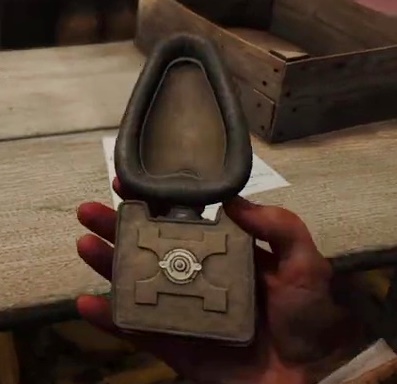 |
Indy acquires a rebreather device
from a village merchant for his upcoming underwater search.
But the small, face-sized rebreather he gets totally does
not exist in the real world even now, let alone in 1937!
Underwater rebreathers are still relatively large
contraptions worn on a person's back or, occasionally, on
the chest. |
Indy shows Sunan a photo of the mountain peak and the man
identities it as Kao Luang in Sukhothai. There is an actual
mountain called Kao Luang in Thailand, but it is about 600
miles away from the location of the historical Sukhothai.
The Wat Mahathat temple he mentions does actually exist in
Sukhothai Historical Park.
Indy's translation of "Wat Mahathat" as "Temple of the Great
Relic" is correct, as is his statement that the temple was
founded by the first king of Sukhothai (Sri Indraditya),
built around the beginning of the 14th Century.
The gigantic snake Indy faces at the temple in Sukhothai
appears to be a reticulated python. The one seen here is
much larger than any known specimen.
Voss remarks, "...you know I had a feeling that
Gantzwurst, that little sausage, would die for his
fatherland." He is referring to Colonel Gantz, having added
-wurst to his name, which is German for "sausage".
Voss refers to Gina as ragazinna. This is Italian
for "little girl".
As Indy mows down fascist soldiers with a machine gun on the
river, Locus says, "Requiescat in pace." This is
Latin for "Rest in peace."
While running through the Fascist/Nazi camp on the way to
rescue Gina, Indy grabs up some pathongko to
restore his energy. Pathongko is a deep-fried strip
of wheat flour.
Ziggurat of Ur
The final chapter of the game takes Indy and Locus to the
Ziggurat of Ur. The Ziggurat of Ur is a Neo-Sumerian temple
at the site of the former city of Ur, near Nasiriyah, Iraq.
Indy's later comments to Gina that the ziggurat was built
around 2000 BC by King Ur-Nammu is correct.
Indy mockingly asks a Nazi soldier he discovers drinking
from a flask if he has the right direction to Baghdad.
Baghdad is the capital of Iraq.
Gina is taken into a Nazi hut with a door labeled
Militarlager. This is German for "military camp".
| All the Nazi
soldiers in the camp are seen to have the same scuff marks
on their helmets! |
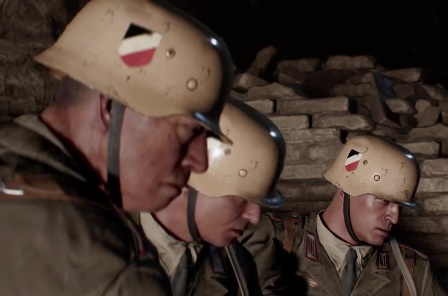 |
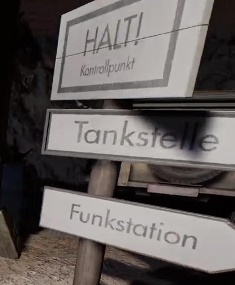 |
Sign in German reads:
STOP! Control point
Gas station
Radio station
|
While running through the Nazi camp on the way to rescue
Gina, Indy grabs up some samoon bread to restore his energy.
Samoon is a type of traditional yeast bread eaten in Iraq.
Sign in German and Italian reads:
NO ENTRY
|
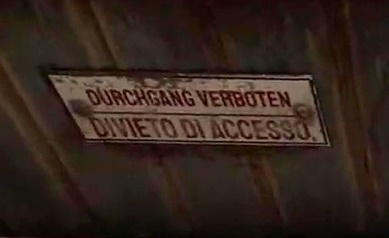 |
In the excavated tunnels underneath the ziggurat, Indy finds
an excavation report that tells of one of the builders of
the ancient temple who traveled north with "a sacred gift"
and founded the city of Nineveh. Nineveh was an Ancient
Assyrian city in Upper Mesopotamia, now the modern city of
Mosul, Iraq.
Upon discovering a giant ark under the ziggurat, Gina
breathes, "Madre mia." This is Italian for "My
mother," an exclamation of surprise.
Indy and Gina uncover that the Nazis have apparently
discovered Noah's Ark beneath the ziggurat. Indy seems to have forgotten that he already came
across the eponymous ark, in a different location (Mount
Ararat, Turkey) in The
Genesis Deluge.
The multiple flood myths Indy discusses with Voss are all
real world ancient myths of a great flood over the world in
pre-history.
The Nazis tow Noah's Ark along twin railroad tracks by two
trains to Lake Hammar and set it afloat. Lake Hammar is an
actual salt water lake in southeastern Iraq.
After capturing Indy and Gina and taking them aboard the
ark, Voss refers to the pair as turteltaubchen.
This is German for "lovebirds".
Voss' storage case for the stones has the original locations of all seventeen
stones on the inner lid, though some of them are a bit hard to
read onscreen. The list is below. All are real world
locations, but the last listed one, Paratoari, is not an
archeological site, featuring several pyramid hills that are
accepted by the scientific establishment as natural
formations.
Tassili n'Ajjer
Siwa
Giza
Petra
Ur
Persepolis
Mohenjo Daro
Khajuraho
Pyay
Sukhothai
Preah Vihear
Aneityum
Easter Island
Nazca
Machu Picchu
Ollantaytambo
Paratoari |
Voss gloats that with all of the stones in his possession,
the German Wehrmacht can now journey instantaneously to
points around the world, such as Times Square, Washington, D.C.,
or in front of Indy's university.
Times Square is a major intersection in Manhattan known for
it's huge and colorful ad displays and has become a symbol
of New York also known as the Crossroads of the World.
Washington D.C.
is, of course, the capitol of the United States.
At the end of the game, Gina
tells Indy, "Addio, strambo." This is Italian for
"Goodbye, weirdo."
Somehow the airplane Gina's flies out on just happens to be
named Laura, the same name as her dead sister.
Memorable Dialog
another foolhardy escapade.mp3
you can't just run away from your problems, Indiana.mp3
I haven't heard that name in a long time.mp3
this American music is astounding.mp3
Father Crescenzo was known mainly for one thing.mp3
you should have become a man of the cloth.mp3
Father Gallagher.mp3
a mummy or a cat.mp3
you're profoundly strange, Dr. Jones.mp3
myth or history.mp3
only one person in the world who knows more about dead languages than me.mp3
let's see if you can keep up.mp3
they're very dead.mp3
make it up as we go.mp3
I have missed our conversations.mp3
you were afraid of becoming your father.mp3
what does the American have?.mp3
Lao Che won't be happy.mp3
just might have a little trouble with the landing, that's all.mp3
I can see how you could drive a woman away.mp3
for what it's worth.mp3
watch out for the snake.mp3
where's that damn snake?.mp3
maybe I should have been an archeologist.mp3
I do this all the time.mp3
better than being a Nazi.mp3
it's Noah's Ark.mp3
one hell of a story.mp3
I found Noah's Ark.mp3
the flood myth and its connection to the Great Circle.mp3
to keep them from men like us.mp3
Back to Indiana Jones Episode
Studies